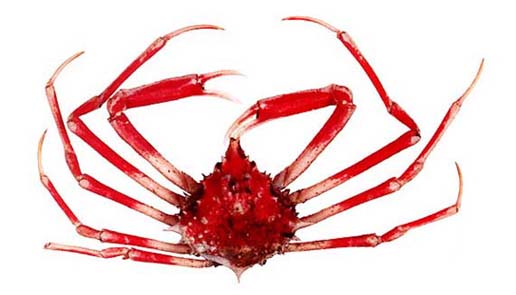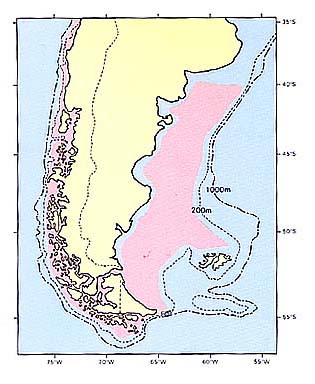クモガニ科
- HOME
- デジタル図鑑
- パタゴニア海域の重要水族
- 節足動物門 甲殻綱 十脚目
- クモガニ科
クモガニ科(Majidae)

140 アシナガツノガニモドキ(Ashinaga-tsunogani-modoki)
Libidoclaea granaria H. Milne Edwards et Lucas, 1842
特 徴:
甲長,甲幅とも突起を含めて約6cm。歩脚の長いカニで,雄でははさみ脚も長い。甲の輪郭は三角形に近い。甲は強く盛り上がることはないが,全体として厚みがあり,側縁部や後部が垂直に近く下を向いて急な斜面を形成している。甲面は胃域,肝域,鰓域,心域,腸域が浅い溝によって分けられているが,鰓域が大部分を占めている。各甲域には大小の突起があるが,小さいもののほぼ左右相称に並んでいる。胃域は正中線に3本,各原胃域の部分にたてに2本が目立つ。肝域は平坦で,側縁に1突起がある。心域は小さいが円錐形で,先端が鋭い突起となる。腸域は縦方向にややふくらみ,正中線後端に心域のものより大きな突起がある。鰓域は多数の突起におおわれるが,甲の側角をなす突起が最大で,側方に突出する。その他に鰓域の後側部にある数本の突起も大きく,心域のものとほぼ同大である。額角は短く,先方1/3ほどがやや下を向き,その部分のみ二叉している。眼窩上縁の前端は突起状で,わずかに外を向く。眼窩外歯はカップ状で,角膜部がおさまる。はさみ脚および歩脚は微小な顆粒でおおわれて,ざらざらしている。はさみ脚の長節は四角柱に近いが,各縁は角ばらない。掌部の断面は楕円形。両指とも切断縁には三角形の小さな歯が規則正しく並んでいる。歩脚の断面は円かやや楕円形で,前方のものほど長い。腕節の上面に縦溝がある。
分 布:
チリ,バルパライソ付近から南方に分布し,マゼラン海峡を経てアルゼンチン,サンマティアス湾沖まで北上している。従来の水深の記録は30〜95m。
備 考:
同属にはチリ沿岸マゼラン海峡まで広く分布するL. smithii(Miers)が知られているが,額角が頭胸甲長(腸域の突起を除く)の1/3に達し,その半分ほどにわたって二叉して,各先端が側方を向いている。また,各甲域の主要な突起が著しく長い。
文 献:
Miers (1886); Rathbun (1925); Garth (1958); Retamel (1981).
(武田正倫)
Material examined:
FSFL EM411 (1♂-42°01′S, 63°58′W, 106 m deep; June 2, 1978); EL869 (1♂-40°01′S, 61°01′W, 40 m deep; June 4, 1978); EL873, EL874 (3 ovig. ♀♀-40°06′S, 56°15′W, 155 m deep; June 8, 1978). Breadth of carapace including lateral tubercles, 3.8-9.2 cm.
Description:
Typical maid crab having long ambulatory legs. Carapace roughly triangular in its outline; dorsal surface divided into regions by shallow furrows, branchial regions of both sides occuping for its large part; regions covered with many tubercles of variable size, which are symmetrically disposed; gastric region with 3 on median line and 2 on protogastric part; hepatic region flattened and tipped by a sharp tubercle on its lateral margin; cardiac region small, but conical, with a sharp tubercle; intestinal tubercle strong; branchial region rather thickly covered with tubercles, of which the one at lateral angle of carapace is as large as the intestinal tubercle and directed laterally; some tubercles on posterolateral margin of branchial region as large as cardiac tubercle. Rostrum short and bifurcated at its distal third. Supraorbital angle sharply tuberculated and directed obliquely outward. External orbital angle cupped to receive cornea. Chelipeds long and stouter than ambulatory legs in male, being thickly covered with fine granules; merus with 4 blunt margins, and palm more or less compressed with obtuse upper and lower margins; fingers sharply and regularly toothed throughout their lengths. Ambulatory legs long and subcylindrical, being covered with thick fine granules.
Distribution:
From Valparaiso, Chile through the Straits of Magellan to off the Gulf of San Matias, Argentina; 30-155 m deep.
Remarks:
Another representative of the genus, L. smithii (Miers) from the Chilean coast, has the longer and deeply bifurcated rostrum with tip directed obliquely outward, and the very long main tubercles on the carapace.
(Masatsune TAKEDA)

Distribution of Libidoclaea granaria in Patagonia.
- 1